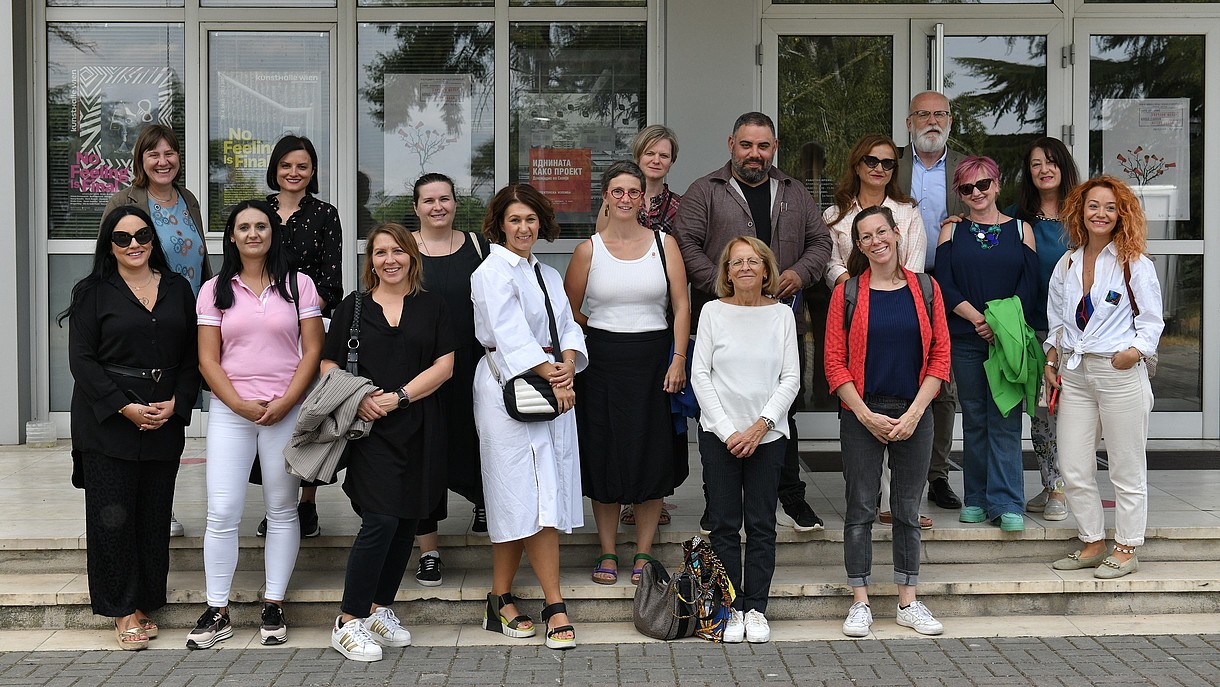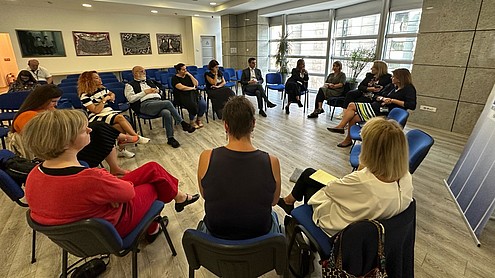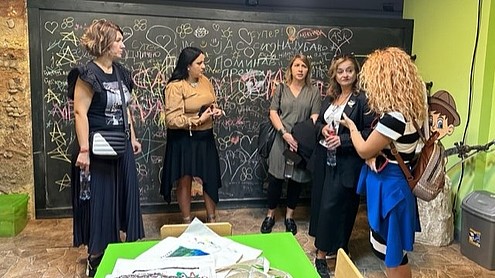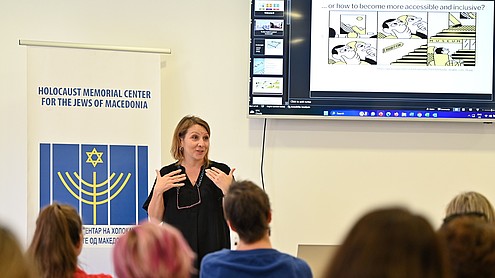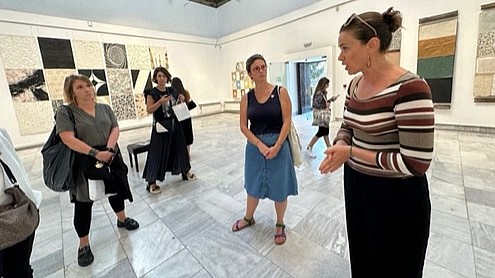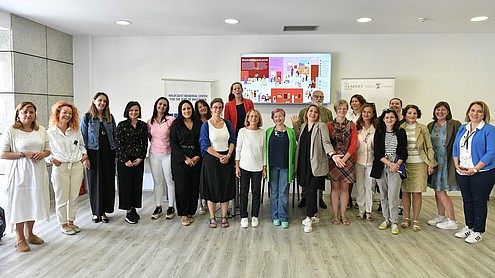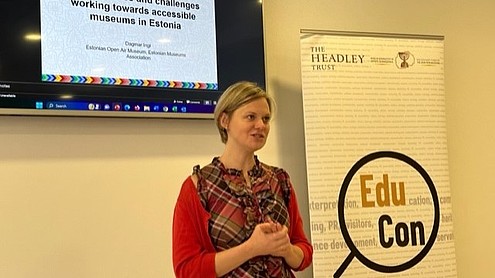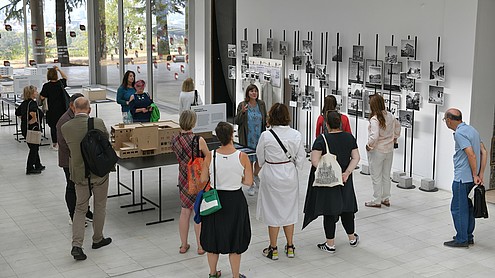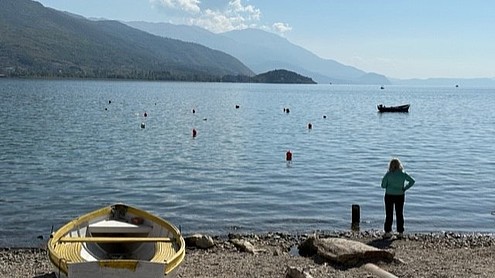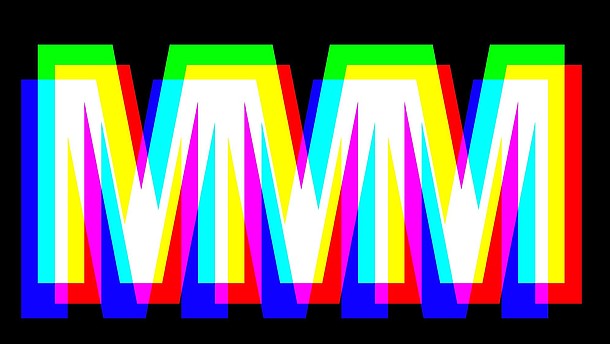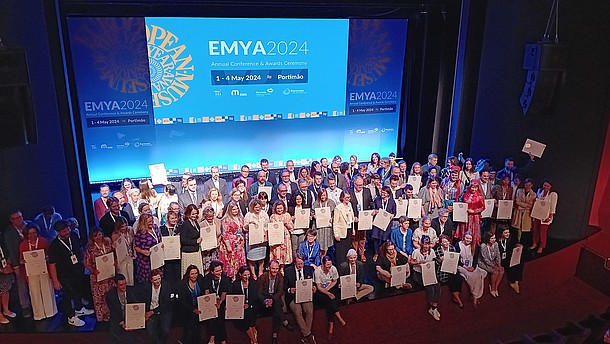On the first day, the group visited and exchanged thoughts about the work of the following museums: Holocaust Memorial Center of the Jews in Macedonia (the group is thankful for an emotional and engaging guided tour in the museum by Maja Bosilkova), Archaeological Museum Skopje, National Gallery / Chifte Hamam and to NEMO member Museum of Macedonian Struggle Skopje.
Special event for museum educators and further study visits
On the second day of the study visit, a small event open to museum educators in Skopje was organised where the six NEMO travel grant holders contributed with presentations about projects and practices in their institution, country or elsewhere related to accessibility and inclusion, which they consider as good practices.
After the event, the group had the pleasure to get a guided tour by the enthusiastic Bojana Janeva in the Museum of Contemporary Art. ICOM North Macedonia president Blagoja Varoshanec joined this meeting. Last visits and nice exchanges were held at the Memorial House of Mother Teresa and Museum of the City of Skopje.
On the third and final day, the participants had the pleasure to be part of a one-day excursion to Ohrid and Bitola, where the group had a final museum visit in the Museum of Bitola, where the very engaged organiser of the working group study visit, Irena Ruzin works. The group wishes to thank Irena for the wonderful days in North Macedonia, full of new input and inspiration.
Six projects on accessibility and inclusion
Below follows the abstracts and presentations of the presentations delivered at the session “Perspectives of Europe - Contributions about Accessibility and Inclusion”. The was very successful and helpful for all participants. Around 20 colleagues from North Macedonia, the majority from Skopje, joined the exchange session.
Towards Accessible Museum
Based on more than 15 years of professional work dedicated to development of museums programs and capacities to become more accessible and inclusive institutions, socially engaged and open for everyone, I would like to share principles and experience that can lead toward accessible museum. I will present elements of the accessible and inclusive programs we have developed and implemented in the Homeland Museum of Knjaževac based on the social model, possible models of cooperation and networking, but also, I would like to share the information about the interactive map of the accessible museums in the Balkans that we as members of the BMAG (BMN) have developed last year.
Best practices and challenges working toward accessible museums in Estonia
Understanding about accessibility in museums has been changed in Estonia in last 15 years. If 15 years ago Estonian museums started to work with people with special needs, main key words were physical accessibility and blind letter. Cooperation between museums and communities was weak and working with people with mental disabilities was almost non-existent.
Although we are still at the beginning, we try to communicate more and more with different communities in developing new programs and exhibitions to make them accessible.
In the presentation I would like to point out and introduce the best examples: Estonian Maritime Museum, Estonian Art Museum and Tartu University Museum and challenges I am facing at Estonian Open-Air Museum working toward accessibility.
Accessibilty beyond the exhibition
In 2019 KBR (Royal Library of Belgium) opened her new exhibition spaces with a block buster exhibition ‘The World of Bruegel in Black an White’. In the meantime, we organise our third exhibition in the same spaces where the showcases, wayfinding and scenography are adapted so that they can check the boxes of accessibility. The exhibition and museum team were guided by an accessibility agency. They helped us and the scenographers to think accessible, which was not always that easy.
We now have experience in accessibility and I’m happy to share some good (and bad) examples of what accessibility can mean in a museum or exhibition.
After some years of experiences with temporary exhibitions and the KBR museum, it is time to broaden our experience and take next steps. KBR wants to be more inclusive. We’ll start with the cultural part of KBR: the KBR museum. We’re situated in the city center of Brussels, we have millions of people passing by our building, but we aren’t aware enough of the neighborhood we’re situated in. Who’s living there and who are the people buzzing around? We plan to do research and get to know those people, invite them, and let them take part in how KBR works, let them know their heritage and how they can become part of it. How we can learn from them and they from us. I would be very happy to test these ideas with the other participants and their experiences.
Museum in pyjamas - Museum educational programme at paediatric hospital clinics
The presentation will introduce outreach programs “Two Museums in the Neighborhood” and “Museum in Pyjamas” which enable vulnerable social groups, such as pediatric patients of two Zagreb hospitals, to learn about museums, heritage and culture. The program “Two Museums in the Neighbourhood” running since 2012 was provided in co-operation with the Museum of Arts and Crafts, in partnership with the Hospital School run by Isidor Kršnjavi Elementary School at the Children’s Hospital Zagreb. Beginning in 2018, a new program entitled “Museum in Pyjamas” was launched in partnership with Petar Zrinski Elementary School and it is provided at the Pediatric Ward of Sisters of Mercy University Hospital in Zagreb. Projects are examples of good cooperation between institutions from three different sectors, culture, health, and education.
Museums for all – Good practices in Montenegro
In the last few years, a significantly different attitude of museum institutions in Montenegro in relation to the needs and inclusion of people with disabilities has been evident. Numerous projects were implemented that aimed to adapt the infrastructure of the museum for the movement of people with disabilities. Several museums realized exhibitions that were intended for people with impaired vision and hearing, for which catalogs with tactile attachments and texts in Braille and also video catalogs in sign language were created. And in some museums tactile contents became part of the permanent museum exhibition. The emphasis of the museum community, i.e. people who work in museums, is on constant education and the adoption of new methods of working with people with disabilities.
Museum accessibility: A checklist
The new ICOM definition refers to a museum as “… a not-for-profit, permanent institution in the service of society that researches, collects, conserves, interprets and exhibits tangible and intangible heritage. Open to the public, accessible and inclusive, museums foster diversity and sustainability.”
The notions of accessibility and inclusivity are key. In 2021 ICOM CECA produced a poster which translates museum accessibility into an infographic showing a selection of 132 ideas to make a museum accessible. The ideas were collected through an online survey answered by 72 museum professionals from 4 continents primarily in the field of accessibility and museum education.
In 2022 the Erasmus+ funded project ART4ALL produced a checklist which can be used by visitors and professionals to assess or self-assess the accessibility of a museum.
Both the poster and the checklist are tools that museum professionals can use to improve accessibility in their own institution.
The resumé of this event was, that the museums will never be able to offer the full range of access to the public, but a clear communication about that is the key factor for all. Also: accessibility is for everyone, families, children, older people – we all have “special needs”.



